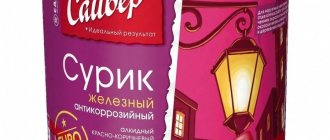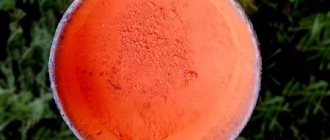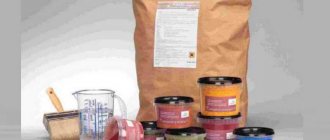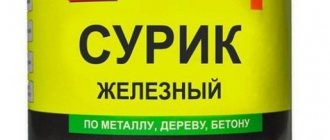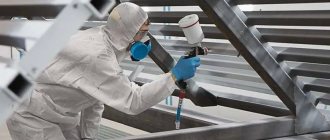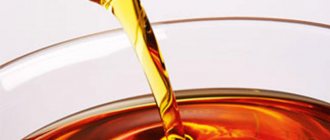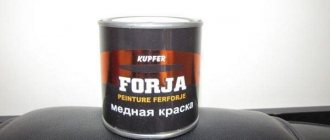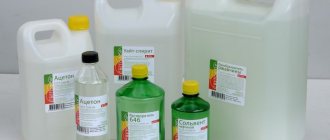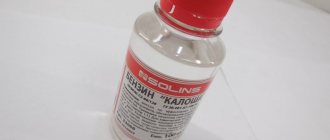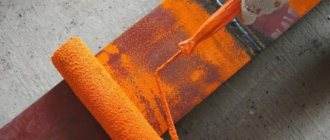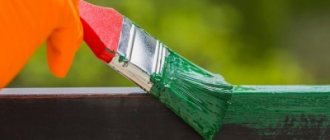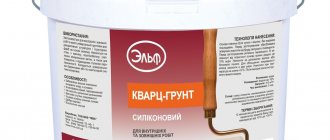Advantages and areas of application
Surik is characterized by many positive qualities:
- temperature resistance (ranging from 50 degrees below zero to 60 degrees above zero);
- hard and stable coating;
- protection of the surface from moisture and chemicals due to the film formed on the base material;
- protection against corrosive processes;
- long service life of the surface;
- economical expense.
Technical features of the material:
- drying time no more than a day;
- conditional viscosity, measured using a VZ-4 viscometer, is no more than 80 - 160 (at temperatures above 20 degrees Celsius);
- hiding power - up to 35 grams per square meter;
- mass fraction of volatile substance – up to 14.5%;
- resistance of the coating to static water for at least 3 hours at 20 degrees Celsius;
- the hardness of the coating when measured using a pendulum device is not less than 0.12 conventional units;
- degree of grinding – up to 80 micrometers;
- mass fraction of film-forming substance - from 27%.
Areas of application of red lead:
- production of varnishes, paints and primers;
- glass industry;
- automotive industry;
- production of plastics (for corrosion protection);
- production of fire-resistant impregnating compounds and paints;
- polishing glass and metal products (used as a fine abrasive).
Application of red lead paint MA-15, MA-015
Preparation of MA-015 red lead paint consists of diluting a thickly grated lump in natural and alkyd drying oils to a painting consistency (30-40% drying oil by weight of the thickly grated paint). To speed up the drying process, driers are additionally added to the paint. It is allowed to use white spirit thinners no more than 5% of the total paint mass. If Oxol drying oil is used for dilution, the resulting paint is suitable only for interior work.
The use of paint is determined by the properties of the pigment and film-forming substance. Iron minium paint MA-15, MA-015 is used for coating metal products used both outside and indoors. When exposed to the atmosphere, a double layer of paint imparts protective properties to the metal in temperate climates for up to one and a half years.
The paint can be used for application to wooden surfaces, for interior and exterior finishing work in construction and renovation. It is used both in everyday life and in industrial work.
Varieties of red lead
In addition to red lead, there is also lead. Both are necessary for the occurrence of an oxidation reaction, during which a special water-insoluble film is formed that does not allow oxygen to pass through. Finished paints and varnishes are created by dissolving an iron or lead base in a liquid medium.
Both types of red lead have their own characteristics and are widely used in industry. The final choice of material depends on the tasks.
Lead minium
The lead-based material is an orange-red or light brown powder. The production technology consists of spraying hot metal lead into the air or oxidizing molten lead in oxygen. The assigned oxide is ground in mills and packaged in barrels or bags.
Red lead is used as an orange pigment in the production of paint, tinting plastics and rubber. The material is a strong oxidizer and is widely used as an anti-corrosion coating for metal surfaces that are used in particularly difficult conditions.
At the same time, red lead is practically not used for individual construction purposes due to its high toxicity. Most countries restrict the production of paints based on it.
Other uses of red lead:
- glass making: optics, crystal, radiation-resistant and protective glass;
- production of explosives;
- as a protective layer against gamma radiation;
- desiccant and catalyst in the chemical industry;
- component of “lead putties”.
The common name for this material is ship or sea red lead. Due to its particularly high thermal and anti-corrosion properties, red lead is used to protect pipelines and in the shipbuilding industry. The high resistance of the paint to the aggressive marine environment makes it possible to use red lead for painting ships and other metal structures that come into contact with sea water. The toxicity of the material in this case is beneficial - the underwater part of the vessel is less overgrown with algae and shells.
When working with the material, it is necessary to adhere to increased safety measures: wear a respirator and protective clothing, and also ventilate the room well.
Iron based material
Red lead has an optimal set of performance characteristics while being more environmentally friendly than lead. The coating is based on a red-brown substance.
This material is produced by calcining iron ore in an oxygen environment. During the production process, oxide is obtained from hot limonite ore. Next, the raw material is crushed to a powder state in a special device called a “screen”. The finished powder is packaged in bags or metal containers for shipment to customers.
Specifications:
- The color of the film is yellow-orange.
- The final drying of the surface occurs in about a day, provided that the temperature is 18-20 degrees above zero.
- The viscosity index is no more than 80 - 160 according to the viscometer readings.
- The hardness of the coating is determined using a pendulum device and must be at least 0.12 conventional units.
- Coating consumption is in the range of 55-240 grams per square meter.
The coating is widely used to protect the undersides of cars and on pipelines. The substance is used to protect metal roofs, manholes, heating equipment (including radiators), and steel garages. Also, red lead is used to protect wood, regardless of whether it is the facade or the inside of the building.
Note! Red lead is not used to protect wood floors.
An example of paint with red lead content is MA-15 enamel. The composition also includes an organic solvent, drying oil and several additives to give the paint special properties.
Note! Mixing silver with red lead leads to an explosive mixture.
Application area
Dry red lead pigment of natural origin, obtained from iron oxide, is used in the production of paints and varnishes (primers, paints and varnishes), the manufacture of plastic and glass products, and in the automotive industry. It is not recommended to use red lead for painting wooden floors.
In shipbuilding, lead-based ship's lead is used. This treatment prevents shells from fouling the bottoms of ships and protects them from the destructive effects of water. Some motorists use similar red lead to treat the bottoms of cars.
The use of red lead has become widespread in private construction to protect metal, concrete and wooden structures. They are processed by:
- fireplaces and stoves;
- ceramic tiles;
- wooden structures;
- metal roofs;
- Garage Doors;
- fencing made of metal and wood;
- car bodies and underbody;
- pipelines and boilers.
Painting with red lead effectively protects the treated surface from moisture, temperature and sunlight, and prevents corrosion processes. The structures acquire a decorative appeal - the paint color is rich, with a glossy sheen.
Iron and lead lead is used as a primer when processing metal structures susceptible to corrosion. The rust layer is removed, the base is degreased for painting and treated with red lead. The primer prevents further corrosion of the metal; decorative enamels and paints can be used as a finishing touch.
In the video: painting the surface with red lead.
Artificial and natural pigments
Dry red lead (pigment) is a finely dispersed powder of various colors, insoluble in a chemical environment. The powder acquires its color by adding inorganic powder to it. The presence of pigment powder in the paint and varnish material significantly increases the metal's resistance to rust, and also improves its resistance to mechanical stress.
In practice, two types of pigments are used: natural and artificial. Synthetics have a rich palette of colors. Natural dyes are produced on the basis of natural components extracted from the depths of the Earth. Natural components are more environmentally friendly and better resist negative environmental factors. Red lead is a natural substance.
In addition to red lead, natural pigments include the following substances:
- ocher;
- chalk;
- umber;
- cinnabar;
- pyrolusite;
- bauxite;
- graphite.
Kinds
Types:
- Iron. It is made on the basis of iron oxide. When iron ore is calcined under the influence of oxygen, a red-brown powder is formed. The resulting composition is crushed and packaged.
- Lead. Has high toxicity. During its production, lead powder is first heated to a high temperature and then sprayed into the air. A lead-based composition is actively used in the exterior finishing of metal structures to protect against corrosion.
The properties of red lead coloring compositions are practically the same - they are equally resistant to temperature changes, exposure to chemicals, etc.
How to breed red lead
Before use, dry minium must be diluted with an organic solvent. Drying oil is best suited for this purpose. Proportions: 20% drying oil to 80% red lead.
It is difficult to qualitatively mix a large amount of pigment in a solvent - lumps form. According to the instructions, the dry powder should be ground in a paint grinder with drying oil to obtain a thick grated oil paint. Before the final application, the thickly rubbed paint is diluted with drying oil or white spirit.
There is a simpler method of breeding, which was used by shipbuilders at shipyards:
- Fill the red lead with water for a day.
- After 24 hours, the water must be drained.
- While mixing the red lead, little by little add natural 100% drying oil.
- After some time, the drying oil will displace the remaining water, which must be carefully drained.
To simplify the mixing process, you can use a screwdriver or a mixer at low speed.
Recommendations for use
The material will last much longer and more efficiently if it is applied to the surface correctly.
Surface preparation
Before applying red lead, the source material is cleaned of dirt, dust, traces of old paint and sanded . Remove rust and degrease with solvent, alcohol or other substance.
Dilution of paint
The result should be a homogeneous consistency without lumps.
Before use, red lead paint for metal and wood is mixed with an organic solvent - drying oil . Add 80% coloring matter and 20% drying oil. You need to mix in small portions to avoid the appearance of lumps. The finished paint should be moderately thick and oily.
You can use the following technology:
- Minium is filled with water for 24 hours.
- Drain the liquid and mix the composition thoroughly.
- Add drying oil a little at a time.
- Leave for another couple of hours until the composition displaces the remaining water.
The easiest way to mix the paint is with a screwdriver with an attachment or a mixer at low speed.
Application of red lead paint
- Before painting, the surface must be prepared. The base must be dry and clean. If metal is to be painted, remove traces of corrosion and also degrease the surface using an organic solvent. If we are talking about wood, we sand and scrape the material.
- Apply paint to the surface using a brush or roller. You can also use a spray bottle, especially in cases where large areas need to be treated. We apply the paint in not too thick layers to avoid drips.
- If painting is done with red lead, you need to stir the composition in the jar as often as possible - heavy lead settles to the bottom faster.
- After painting is completed, clean the used tool with a solvent. We wipe the brushes with a dry cloth, and then saturate the bristles with vegetable oil.
Precautionary measures
The instructions from the manufacturer contain mandatory safety measures that must be followed when applying red lead paint. These recommendations must be taken seriously.
You will need a respirator, rubber apron and gloves, as well as safety glasses. Upon completion of work, long-term (at least 2 days) ventilation of the premises is necessary.
Interesting fact about iron oxide
Everywhere, the idea of protecting iron and steel from corrosion came in the 18th century, and in the 19th century it was recommended to use a primer with red lead for treating metal surfaces. A striking example of the durability of the coating and the high anti-corrosion properties of red lead is the Eiffel Tower. After the presentation of the design project in Paris, the question arose about protecting steel elements from corrosion under the influence of precipitation.
Each of the tower's fifteen thousand steel parts and two and a half million rivets was treated with red lead as a primer. Later, iron oxide – red lead, ocher and iron mica – were used to restore the anti-corrosion coating. The surface of the Eiffel Tower structure has received reliable protection.
Oil paint, which is based on red lead and drying oil, forms a thin layer on the painted surface that preserves metal and wood from the negative effects of precipitation and chemical agents. This treatment is an effective method of anti-corrosion, heat-resistant and moisture-proof coating for the protection of domestic and industrial structures.
Methods for obtaining red lead (2 videos)
Iron oxide and paint based on it (25 photos)
Alternative solutions
If lead paint is not the best solution for some reason, you can think about an alternative. Finding a replacement for red lead is not so easy, especially one that is price competitive. However, the following options can be recommended:
- Electrically conductive paint "Zinga". This paint and varnish material contains zinc. Paint is widely used to protect cast iron and steel from rusting. The substance can be applied to metal over a very wide temperature range.
- Another replacement option is fire-retardant paint “Polistil”. This paint and varnish composition corresponds to the fourth fire safety group. Coatings treated with Polistil last for at least ten years.
In conclusion, it is necessary that “Polistil” will not become a full-fledged replacement for red lead. Therefore, if environmental considerations are not decisive, it is still better to give preference to red lead-based paint.
Selection principles
Criterias of choice:
- best before date;
- container volume;
- resistance to temperature changes and moisture;
- shade;
- viscosity.
Advantages and disadvantages
Pros:
- resistance to temperature changes within -50–+60 °C;
- economical consumption;
- protection of the base from rust formation and exposure to chemicals;
- high strength of the hardened paint layer;
- immunity to mechanical stress;
- durability.
The main and only drawback of red lead paint for metal is its high toxicity. When working, you need to use a respirator, safety glasses, and rubberized gloves.
Respirator (Photo: pixabay.com)
TOP 10 manufacturers
Manufacturers:
- "SpecialEnamel";
- "EXPERT";
- "LAKRA";
- "KRAFOR";
- Tikkurila;
- Golden Farb;
- Zlata;
- NORMA;
- PROFILUX;
- TURY Scandinavia.
The average cost is 500 rubles for 3 kg of enamel.
Description and application of red lead (breeding guide)
Red lead is a chemical-resistant substance. It is insoluble in an aqueous environment and is resistant to sulfur dioxide.
Short description
Red lead or lead oxide is a naturally occurring pigment that is light brown or orange in color. Its formula is Pb3O4. The material is included in paints as a coloring element, and is also used in putties or primers as an anti-corrosion agent.
The size of the fine powder fractions is 2-10 microns. Produced by oxidation under high temperatures. Used batteries are used to extract lead.
The use of red lead in building materials increases their anti-corrosion properties. The oxide film appears when it reacts with metal surfaces; it protects products from corrosion. The production of the chemical compound is carried out at specialized chemical plants.
It is worth noting that this substance belongs to the first hazard class, since it is highly toxic and falls into the category of carcinogens. Based on these conclusions, red lead cannot be used in the domestic sphere.
Areas of use
The main use of natural pigment is to treat surfaces that are most susceptible to negative atmospheric influences and aggressive environments from salt water.
High adhesion properties ensure strong adhesion of the material to the surface.
Due to its properties, the material is used for painting marine vessels, cars and other structures susceptible to corrosion are treated with it.
This material is used:
- in the manufacture of glass (optical, crystal, radiation-resistant glass);
- as a catalyst in building materials;
- in order to protect embedded elements in reinforced concrete structures from corrosion;
- for the production of explosives;
- for the manufacture of batteries;
- for painting cars;
- in putties.
Ship or sea red lead is in demand among consumers. The fact is that during the operation of a marine vehicle, the underwater part of the vessel becomes heavily overgrown with algae, which interferes with normal movement, and since red lead is poisonous, this does not happen.
Particular care is required when painting the underbody of a car, since this critical part is most susceptible to corrosion. The use of red lead in this case will protect the metal.
On video: treating rust with red lead.
How to use red lead
To paint metal surfaces, the following operations are required:
1. Preparation of paint for work. Lead-based paint is diluted with a solvent, so it dilutes better. The solvent can be white spirit, solvent or solvent with toluene (in equal proportions). It should be diluted gradually until the desired consistency is achieved, and when diluting, do not forget about safety measures.
2. Surface preparation. The base is cleaned and treated using a degreaser. Metal brushes are used to remove rust; any of the above solvents can be used.
Important! During use, the material is mixed so that lead particles do not settle to the bottom, and this condition must be met as often as possible
How to dilute powder pigment
Minium powder should be diluted before use, otherwise it will not perform painting operations. For everything to work out successfully, you need to read the manufacturer's instructions. Recommended process:
- Preparation of materials: drying oil (preferably on a natural basis), part of the red lead powder, solvent (corresponding to the drying oil taken), drier and turpentine.
- Description of work: pour drying oil into a container, add pigment, turpentine and drier there. Dilute to a homogeneous consistency and mix thoroughly.
To avoid splashing on the sides during the period when the pigment was diluted in drying oil, you can put a circle of cardboard on the container. It is better to use red lead diluted in drying oil and paint at a time to avoid the formation of a surface film.
Why is silver added to red lead? %|
Aluminum is a fairly active metal. At room temperature, compact aluminum is protected by an oxide film that prevents further oxidation. However, even finely dispersed aluminum is pyrophoric: it can ignite when stored in air. As you know, aluminum powder (“silver powder”) is used as a pigment. To prevent aluminum powder from catching fire (and sticking together), special additives are added to it. Aluminum powder forms mixtures with many solid oxidizing agents that flash or explode when heated. One such oxidizing agent is red lead, which is sold in hardware stores as a pigment. The reaction between lead lead and aluminum can be represented by the equation: 3Pb3O4 + 8Al = 4Al2O3 + 9Pb or Pb3O4 + 8/3Al = 4/3Al2O3 + 3Pb Molar mass of Pb3O4 - 685.57, Al - 26.98 g / mol. For example, for 10 g of red lead, theoretically you need 10/685.57 26.98 8/3 = 1.05 g of aluminum However, firstly, “silver” is not 100% aluminum (see note), and secondly, the role of an oxidizing agent Air oxygen can also play a role - after the reaction of aluminum and lead oxide Pb3O4, an outbreak of excess aluminum in air will occur. Therefore, it is advisable to take more aluminum powder than follows from the reaction equation. In a trial experiment, I took 1 g of red lead and 1 g of silver (a large excess of aluminum, but I didn’t know that at the time). The mixture was ignited using stopine. When the flame acted, a bright flash immediately occurred. After that, I decided to try how a mixture of red lead and silver reacts in “large” quantities, and in a shell. I weighed out 5 g of red lead and 0.55 g of aluminum powder (it is easy to calculate that there is a slight excess of aluminum). I mixed it, poured it into a syringe, inserted the plunger and gently pressed it, the volume of the mixture became a little more than 4 ml. Instead of stopine (for lack of availability), I took “caramel” paper (initially I didn’t know how the mixture would behave, but after the “test” I realized that it was advisable to use stopine with it - you shouldn’t trust a paper retarder when working with powerful mixtures). Then I thought about it and installed another piston (for strength). I didn’t “test” the mixture on the site, since the released lead is not particularly “useful,” so I went into the forest. I secured the syringe to the tree using electrical tape. The “explosion” was VERY loud (naturally, for such a small amount of mixture). A large cloud of dust formed. You should never inhale this smoke, as it contains a lot of lead! The tree was covered with a gray coating, sometimes black. There was almost no damage, the only thing was slight damage to the bark (the white stripe in the last photo), and something else hit the camera lens immediately after the “explosion.” The composition of aluminum powder and red lead in an amount the size of a match head is quite suitable for electric igniters, but such experiments are rather pampering, because For this purpose, it is advisable to use black powder with a small addition of silver powder. In conclusion, let me remind you once again that lead compounds are poisonous: soluble salts, dust of solid compounds, and vapors of metal lead. Mixtures containing red lead or lead dioxide should not be burned indoors. For testing, it is better to choose a deserted place, and move away to a sufficient distance so as not to inhale smoke. And most importantly, such mixtures should not be abused: try it a few times, see it, and that’s enough. After this, it is better to switch to experiments with safer substances. _____________________________________________________ 1 The composition of aluminum powder of different brands is regulated by GOST 5494-95 Aluminum powder. Specifications. As can be seen from this document, the aluminum content in aluminum powder is 86-90% - this is if it is of high quality and complies with GOST conditions. Unfortunately, counterfeits are now often sold under the name “aluminum powder”, in which aluminum powder is diluted with various ballast such as cement. Before you start experimenting with aluminum powder, I recommend making sure what kind of powder you are dealing with. A pile of high-quality powder should light up when exposed to a flame. 2 It is advisable to make sure that instead of red lead they don’t give you red lead: some sellers don’t even understand the difference between these pigments. 3 To obtain a stronger lighting effect, the amount of silver can be increased up to 35% above what is required (for pure aluminum). A larger excess does not make sense.
